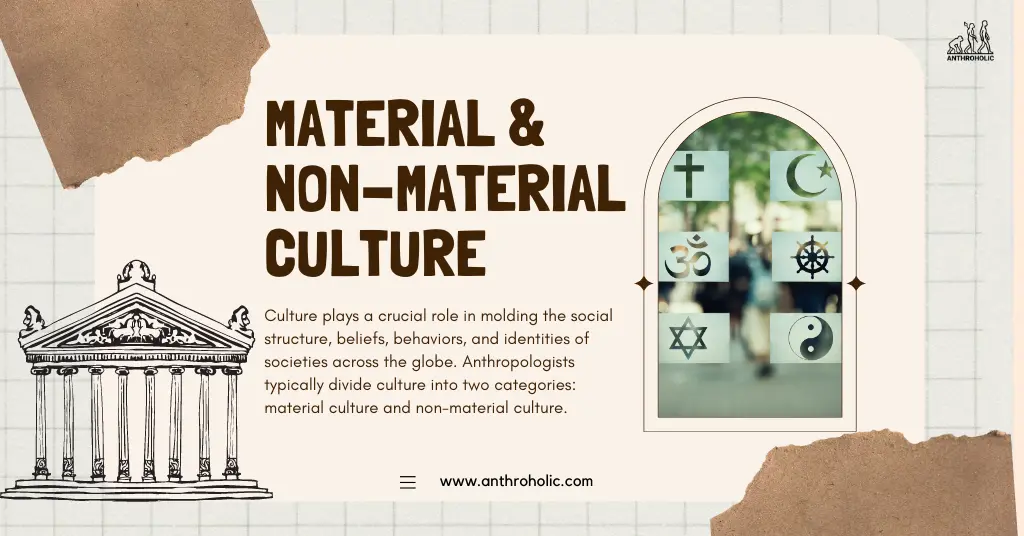AI Answer Evaluation Platform Live Now. Try Free Answer Evaluation Now
Material and Non-material Culture
Culture plays a crucial role in molding the social structure, beliefs, behaviors, and identities of societies across the globe. Anthropologists typically divide culture into two categories: material culture and non-material culture.

Material Culture
Material culture refers to the physical objects, artifacts, and spaces that people create and use to define their culture. These items are tangible and observable, embodying the values, beliefs, norms, and technologies of a society.
Examples of Material Culture
Material culture can manifest in numerous forms:
- Architecture: The buildings, monuments, and spaces people create, like the pyramids of Egypt, the Eiffel Tower in France, or the Great Wall of China. These architectural works reflect the technological abilities, aesthetics, and beliefs of their creators [1].
- Art: Paintings, sculptures, pottery, and other artistic creations. For instance, Renaissance art is a testament to the period’s religious and philosophical beliefs.
- Technology: Tools and machinery. Stone tools from prehistoric cultures to the modern smartphones demonstrate the progression of human innovation.
- Clothing: Traditional dresses like Japanese kimonos or Scottish kilts symbolize cultural identity.
- Food: Specific cuisines associated with cultures, like Italian pasta or Indian curry, are part of material culture.
Custom Challenge Coins are also a kind of material culture. In the construction and inheritance of cultural identity.
Custom Challenge Coins can be used as a concrete carrier to carry cultural symbols and strengthen identity. Through unique design and interactive forms, they deeply integrate material culture and intangible culture, becoming a link between individual and group cultural identity.

Table 1. Some Examples of Material Culture
| Category | Example | Description |
|---|---|---|
| Architecture | Pyramids of Egypt | Reflects ancient Egyptian engineering, religious beliefs |
| Art | Renaissance paintings | Symbolizes religious and philosophical beliefs of the era |
| Technology | Smartphones | Signifies contemporary technological capabilities |
| Clothing | Scottish kilts | Represents cultural identity |
| Food | Indian curry | Exemplifies cultural tradition and taste preferences |
Non-Material Culture
Non-material culture refers to the intangible aspects of a society’s culture, including values, norms, language, beliefs, and symbolic meanings. It represents the unseen spiritual and intellectual substance of a society’s culture [2].
Examples of Non-Material Culture
Non-material culture encompasses a broad range of elements, such as:
- Values: The deeply ingrained principles that guide behavior, like respect for elders in Asian cultures.
- Norms: The expectations or rules within a society, like the driving laws or social etiquette.
- Language: The spoken and written words, gestures, and other communication forms that carry cultural meanings.
- Beliefs: Religious, spiritual, or philosophical convictions.
- Symbols: Items or signs that carry particular meanings, like a nation’s flag representing patriotism and national identity.
| Category | Example | Description |
|---|---|---|
| Values | Respect for elders in Asian cultures | Defines societal principles and guides behavior |
| Norms | Social etiquette | Establishes rules for social interaction |
| Language | English | Communication medium carrying cultural meanings |
| Beliefs | Christianity | Expresses religious convictions |
| Symbols | American Flag | Symbolizes patriotism and national identity |

The Relationship Between Material and Non-Material Culture
Material and non-material cultures are not isolated but interact and influence each other constantly. For instance, a society’s values (non-material culture) often influence its architecture and art (material culture). Conversely, technological innovations (material culture) can impact societal norms and behaviors (non-material culture) [3].
Exploring Material Culture
Material culture studies involve a multi-disciplinary approach. Archeologists, anthropologists, and historians all delve into material culture, focusing on how human-made artifacts reveal clues about societies, their values, lifestyles, and technologies. This exploration often involves examining the production methods, usage, and societal significance of various artifacts [4].
Importance of Material Culture
Material culture serves as the tangible evidence of a society’s history and cultural practices:
- Historical Documentation: Artifacts serve as physical records of history, providing evidence of past societies, events, and lifestyles.
- Cultural Expression: Material culture offers insights into the aesthetic tastes, religious practices, and technological prowess of a society.
- Identity Representation: Objects like national flags, traditional clothing, and monuments often symbolize a culture’s identity and heritage.
Diving into Non-Material Culture
Non-material culture, though intangible, is equally significant in understanding societal norms, beliefs, and behaviors. Sociologists, anthropologists, and linguists are some of the professionals involved in studying non-material culture, deciphering its influence on societal structures, identities, and worldviews [5].
Importance of Non-Material Culture
Non-material culture holds significant weight in shaping society’s norms, behaviors, and values:
- Social Cohesion: Shared norms, values, and beliefs foster a sense of community, encouraging societal unity.
- Behavior Regulation: Societal norms guide individual behavior and help maintain societal order.
- Cultural Continuity: Language, folklores, traditions, and beliefs ensure the transmission of cultural heritage across generations.
The Interplay between Material and Non-material Culture
The interaction between material and non-material culture shapes our world in profound ways. Changes in one often lead to changes in the other, creating a dynamic, ongoing cultural evolution. For example, technological advances (material culture) have led to new modes of communication, transforming societal norms and behaviors (non-material culture). Conversely, shifts in societal values and norms (non-material culture) can drive innovation and change in material culture [6].
Conclusion
In conclusion, culture is a complex tapestry woven from both tangible objects and intangible ideologies. Material culture provides a physical testament to a society’s progression, creativity, and technology. In contrast, non-material culture carries the unseen, yet essential aspects of societal values, norms, and beliefs. Understanding both these facets is crucial to grasping a society’s complete cultural identity.
References
[1] Trigger, B. G. (2007). A History of Archaeological Thought. Cambridge University Press.
[2] Ingold, T. (2013). Making: Anthropology, Archaeology, Art and Architecture. Routledge.
[3] Malafouris, L. (2013). How things shape the mind: A theory of material engagement. MIT Press.
[4] Hicks, D., & Beaudry, M. C. (2010). The Oxford Handbook of Material Culture Studies. Oxford University Press. http://dx.doi.org/10.1093/oxfordhb/9780199218714.001.0001
[5] Geertz, C. (1973). The Interpretation of Cultures. Basic Books.
[6] Miller, D. (2010). Stuff. Polity.




